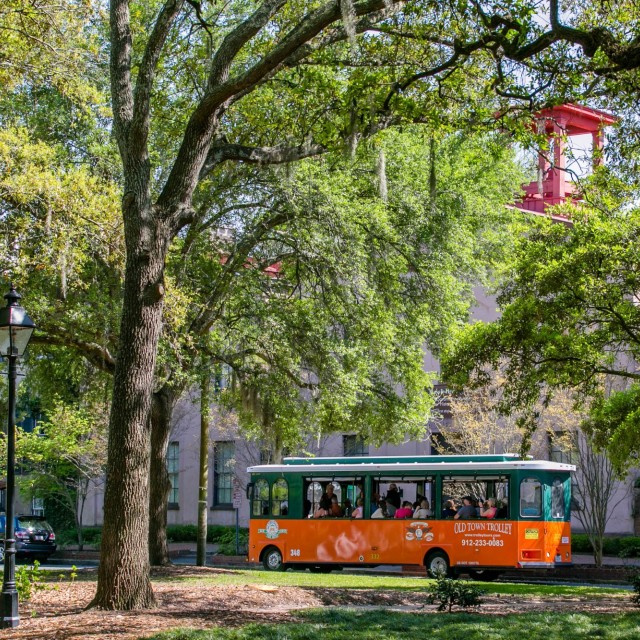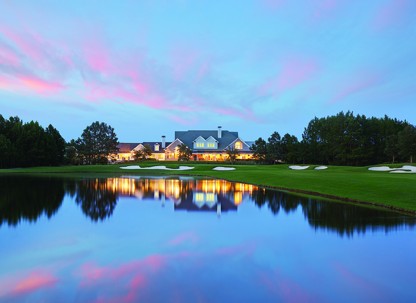Savannah's Squares and Parks

Lafayette Square
The squares and parks of Savannah are the community's most beloved icons. Originally designed with 24 squares, 23 remain today to be enjoyed by the millions who grace their grassy utopias every year.
Taylor Square (The Square Formerly Known as Calhoun)
Abercorn and Wayne Streets
The square formally known as Calhoun was designed in 1851 and named in honor of John C. Calhoun, a South Carolina statesman and Vice President under John Quincy Adams and Andrew Jackson. It's the only square where all of the original historic buildings remain. Calhoun Square has since been renamed Taylor Square in honor of Susie King Taylor. Born into slavery, Susie King Taylor was secretly educated by her freed grandmother in Savannah. At age 14, she became the first black teacher to educate African Americans in Georgia and served as a nurse during the American Civil War. She later opened a school in Savannah for African-American children and published a memoir about her experience with the 33rd United States Colored Troops.
Located on the square: Massie School and Wesley Monumental United Methodist Church
Chatham Square
Barnard and Wayne Streets
Chatham Square was designed in 1847 and named in honor of William Pitt, the Earl of Chatham. Pitt was an early supporter of the colony and though he never visited Savannah, Chatham County and Chatham Square were named in his honor.
Located on the square: Gordon Row, 15 four-storied townhouses each 20 feet wide with identical architecture.
Chippewa Square
Bull and McDonough Streets
Chippewa Square was designed in 1815 and named to commemorate the Battle of Chippewa in the War of 1812. In the center stands a bronze statue of the colony's founder, General James Edward Oglethorpe, who faces south protecting Savannah from the Spanish in Florida.
Located on the Square: First Baptist Church, the Savannah Theatre and the Eastman-Stoddard House. Also known as Forrest Gump Square, the bus stop scenes from the Oscar winning motion picture were filmed on the north end of the square.
Columbia Square
Habersham and Presidents Streets
Columbia Square was designed in 1799 and named "Columbia," the female personification of the United States of America. In the center sits a fountain from the Wormsloe Plantation, an early Savannah settlement.
Located on the square: The Davenport House and the Kehoe House
Crawford Square
E. Hull and Houston Streets
Crawford Square was designed in 1841 and named in honor of William Harrison Crawford, Minister of France during the reign of Napoleon. Crawford was said to be the only foreign politician with any influence over Napoleon.
Elbert Square
Houston and McDonough Streets
Lost to urban sprawl, Elbert Square was designed out in 1801 between Montgomery and McDonough streets. It was named in honor of Samuel Elbert, a Revolutionary War hero and Georgia Governor.
Ellis Square
Bryan and Barnard Streets
Once lost to urban sprawl, the old city square was restored thanks to a public/private partnership by the City of Savannah and area developers. The restored square features underground parking, retail centers and hotels. Ellis Square was designed in 1733 and was named in honor of Henry Ellis, the second Royal Governor. It was here that the "Old City Market" was located and merchants sold crops and wares.
Franklin Square
Bryan and Barnard Streets
Franklin Square was designed in 1791 and named in honor of Benjamin Franklin, for many years the square was the site of the city's water tower and was referred to as "water tower square."
Located on the square: First African Baptist Church and the west end of City Market
Greene Square
Houston and President Streets
Greene Square was designed in 1799 to honor General Nathanael Greene, a Revolutionary War hero who fought against the British in Savannah.
Located on the square: Second African Baptist Church
Johnson Square
Bull and St. Julian Streets
Johnson Square was designed in 1733 and named for Robert Johnson, the Royal Governor of South Carolina when Georgia was founded. Johnson Square was the first of Savannah's 24 squares and served as its commercial hub. In the center stands a monument of General Nathanael Greene, a Revolutionary War hero and Savannah patriot.
Located on the square: Christ Episcopal Church
Lafayette Square
Abercorn and Macon Streets
Located on the square: The Hamilton-Turner House, the Cathedral of St. John the Baptist, the Low-Colonial Dames House and the childhood home of author Flannery O' Conner
Liberty Square
Lost to Urban Sprawl
Lost to urban sprawl, Liberty Square was designed in 1799 between Montgomery and Presidents Streets and named to honor Savannah patriots, the "Liberty Boys." The Liberty Boys were instrumental in setting the stage for Georgia's involvement in the American Revolution.
Madison Square
Bull and Macon Streets
Madison Square was designed in 1837 and named to honor James Madison, the fourth president of the United States. In the center stands a monument of Sergeant William Jasper who fell during the Siege of Savannah in 1779. A granite marker denotes the southern line of the British defense during the 1779 battle.
Located on the square: St. John's Episcopal Church, the Green-Meldrim House and the Sorrel-Weed House
Monterey Square
Bull and Wayne Streets
Monterey Square was designed in 1847 and was named to commemorate the 1846 Battle of Monterey during the Mexican American War. It was the battle of the Mexican War in which a Savannah unit of the Irish Jasper Greens fought. The square's monument honors Casimir Pulaski, a Polish nobleman who was mortally wounded during the Siege of Savannah while fighting for Americans.
Located on the square: Temple Mickve Israel and the Mercer House
Oglethorpe Square
Abercorn and Presidents Streets
Orleans Square
Barnard and McDonough Streets
Orleans Square was designed in 1815 in honor of the heroes of the Battle of New Orleans during the War of 1812. The fountain in the square was dedicated in 1989 by Savannah's German Society to recognize the contributions of Savannah's early German immigrants.
Located on the square: The Champion-McAlpin House
Pulaski Square
Barnard and Macon Streets
Reynolds Square
Abercorn and St. Julian Streets
Reynolds Square was designed in 1733 and named for Georgia's first Royal Governor, John Reynolds. In the center stands a monument to John Wesley, the founder of Methodism and the Anglican minister to the colony in 1736.
Located on the square: The Olde Pink House and the Lucas Theatre
Telfair Square
Barnard and President Streets
Telfair Square was designed in 1733 as St. James Square; and it was renamed in 1883 to honor Edward Telfair a three-time governor of Georgia and patron to the arts.
Located on the square: Trinity United Methodist Church, the Telfair Museum of Art and Jepson Center for the Arts
Troup Square
Habersham and McDonough Streets
Troup Square was designed in 1851 and named in honor of George Michael Troup, a Senator and Governor of Georgia. In the center stands the Armillary Sphere a astronomical device designed to show the relationship among the celestial circles.
Located on the square: The Unitarian Universalist Church and the McDonough Row Houses
Warren Square
Habersham and St. Julian Streets
Warren Square was designed in 1791 and named in honor of General Joseph Warren who was killed at the Battle of Bunker Hill during the Revolutionary War.
Washington Square
Houston and St. Julian Streets
Washington Square was designed in 1790 and named to honor George Washington, the first President of the United States. Some of the oldest houses in Savannah reside on this square.
Whitefield Square
Habersham and Wayne Streets
Whitfield Square was designed in 1851 and was the last of the Savannah squares. Named to honor Reverend George Whitefield, founder of the Bethesda Orphanage, the oldest orphanage in the United States. A gazebo sits in the center and Victorian architecture is prominent in this area.
Located on the square: The First Congregational Church
Wright Square
Bull and President Streets
Wright Square was designed in 1733 and named for Sir James Wright, Georgia's third and last colonial governor. The monument in the square honors William Washington Gordon, an early mayor of Savannah who established the Central of Georgia Railroad. The large boulder marks the grave of Tomochichi, the Yamacraw Indian Chief who welcomed General Oglethorpe and the first colonists.
Located on square: Lutheran Church of the Ascension
Yamacraw Square
Bay and Bryan Streets
The former Yamacraw Art Park has been transformed into Savannah's 23rd square: Yamacraw Square. Following community advocacy and a City Council vote, the space has been revitalized with restored statues, new historical markers, fresh surfacing, and inviting benches. Local artist Jerome B. Meadows led the restoration and contributed new artwork, reestablishing the area's historic charm.
Located on square: First Bryan Baptist Church
Emmet Park
Bay Street Between Abercorn and East Broad
Forsyth Park
Bull and Gaston Streets
This 30-acre park is bordered on the north by Gaston Street, on the south by Park Avenue and has a one-mile perimeter popular among outdoor enthusiasts. The northern section of the park was donated to the city by William Hodgson, a private citizen, who felt the city needed a large public park. In 1851 the park was expanded and named for John Forsyth, a Georgia Governor. The park's north end is home to a cast iron fountain that was erected in 1858. The Forsyth Park Fountain was designed to resemble the grand fountain in Paris at the Place de la Concorde. An exact replica of the Forsyth Park Fountain resides in Cuzco, Peru. The park is also adorned by monuments to the Confederate Soldier, the Marine Corps Monument, the Spanish-American Monument and the Fragrant Garden for the Blind. The Forsyth Park Fountain is one of the most visited attractions by visitors to Savannah.
Morrell Park
River Street and East Broad Ramp
This riverside park is home to one of Savannah's most beloved figures, The Waving Girl. The statue commemorates Florence Martus, the lighthouse keepers' sister who waved to ships in Savannah's port for more than 44 years. She stands as a symbol of Savannah's gracious Southern hospitality and charm. Also located at Morrell Park is Savannah's Olympic Flame. Savannah was the site of the 1996 Olympic yachting events. It burned throughout the duration of the centennial games in Atlanta.
























